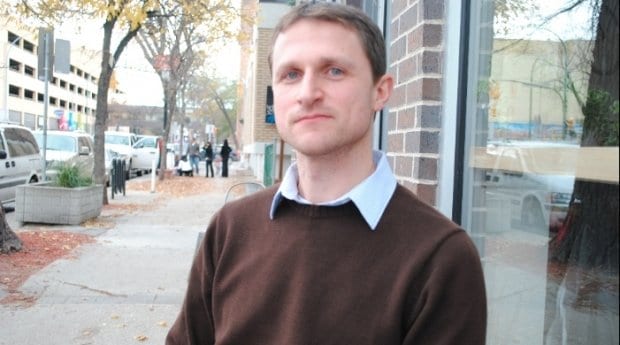One Gay City: A History of LGBT Life in Winnipeg made its world premiere on Oct 18 during the Reel Pride queer film festival in Winnipeg. The documentary by Aaron Floresco summarizes the struggles and successes of Winnipeg’s LGBT community from the 1960s to today.
“I came out in 1985, so I saw a lot of the progression,” says audience member Paula Legal, who brought her partner and parents to the movie’s premiere.
One scene in the film discusses Winnipeg’s first Pride, in 1987, where some of the 250 people marching wore bags over their heads to conceal their identities. That day Legal proudly displayed her identity with her motorcycle and girlfriend.
The film’s narrative is supplied through interviews with local gay and lesbian pioneers supplemented by archival audio and photos. The MTS Stories from Home documentary covers major events, such as the city’s homophobic police morality team, the decriminalization of homosexuality, the rise of gay bars, the outbreak of AIDS and the legalization of same-sex marriage.
Leslie Hatrick, who moved to Winnipeg in 1975 and remembers some of the pivotal events mentioned in the film, attended the screening. Hatrick lived in the same building as Chris Vogel and Richard North, who fought to have the province legally recognize their marriage in the 1980s.
Vogel and North were interviewed for the film and spoke about the experience of being the second gay couple in Canada to fight to have their marriage sanctioned. North also advocated for the Manitoba Human Rights Code to include sexual orientation and went on a 59-day hunger strike in 1985.
“It was a trip down memory lane,” Hatrick says.
The film features other big players in Winnipeg’s local gay history, such as Ruth Krindle, the first federally appointed lesbian judge; Glen Murray, the first openly gay mayor of a large North American city; and Sally Papso, a retired correctional officer. Artists Shawna Dempsey and Lorri Millan, musician Heather Bishop and filmmaker Noam Gonick shared stories about being out in the arts and culture scene.
Some lesser-known local gems were also featured, including “The Hill,” a meeting place for gay men on the bank of the Assiniboine River behind the Manitoba Legislative Building.
Floresco also included archival footage of Coming Out, a gay TV program from the 1980s. At the time, it was unheard of for gay people to show their faces on TV.
Over an 18-month period, Floresco conducted interviews and research, perused archives and spent countless hours editing — something he’s used to. His other work includes a historical documentary on Winnipeg’s red-light district and If Day, a documentary about a simulated Nazi invasion that took over the city on Feb 19, 1942.
Floresco says One Gay City is a good reminder of how Winnipeg’s LGBT community has achieved the equality it enjoys today. “I think it’s important to remember that and realize what it takes to make change happen in society.”
He notes that many of the stories in his film haven’t been told in a documentary before, which is what motivated him to create the film. “I tried to give the doc a feel of a mixture of Winnipeg-specific stories or Winnipeg-specific firsts, like Glen Murray or like Chris Vogel and Richard North, but a lot of it is universal,” he says. “I’ve given it that mix so people can relate to it wherever they’re from.”
Relating to One Gay City was no problem for Reel Pride.
“It explains how we got here. There were some exceptional pioneers that were breaking ground,” Eric Plamondon, Reel Pride’s director of marketing, points out. “We’re not done writing the gay and lesbian history of Winnipeg. We’re still in the process of writing it, so to know where you’ve been and where you come from and where you still need to go, that’s hugely important.”
One Gay City will be available free on MTS Stories from Home in a couple of weeks. Copies will also be available soon for purchase.

 Why you can trust Xtra
Why you can trust Xtra


